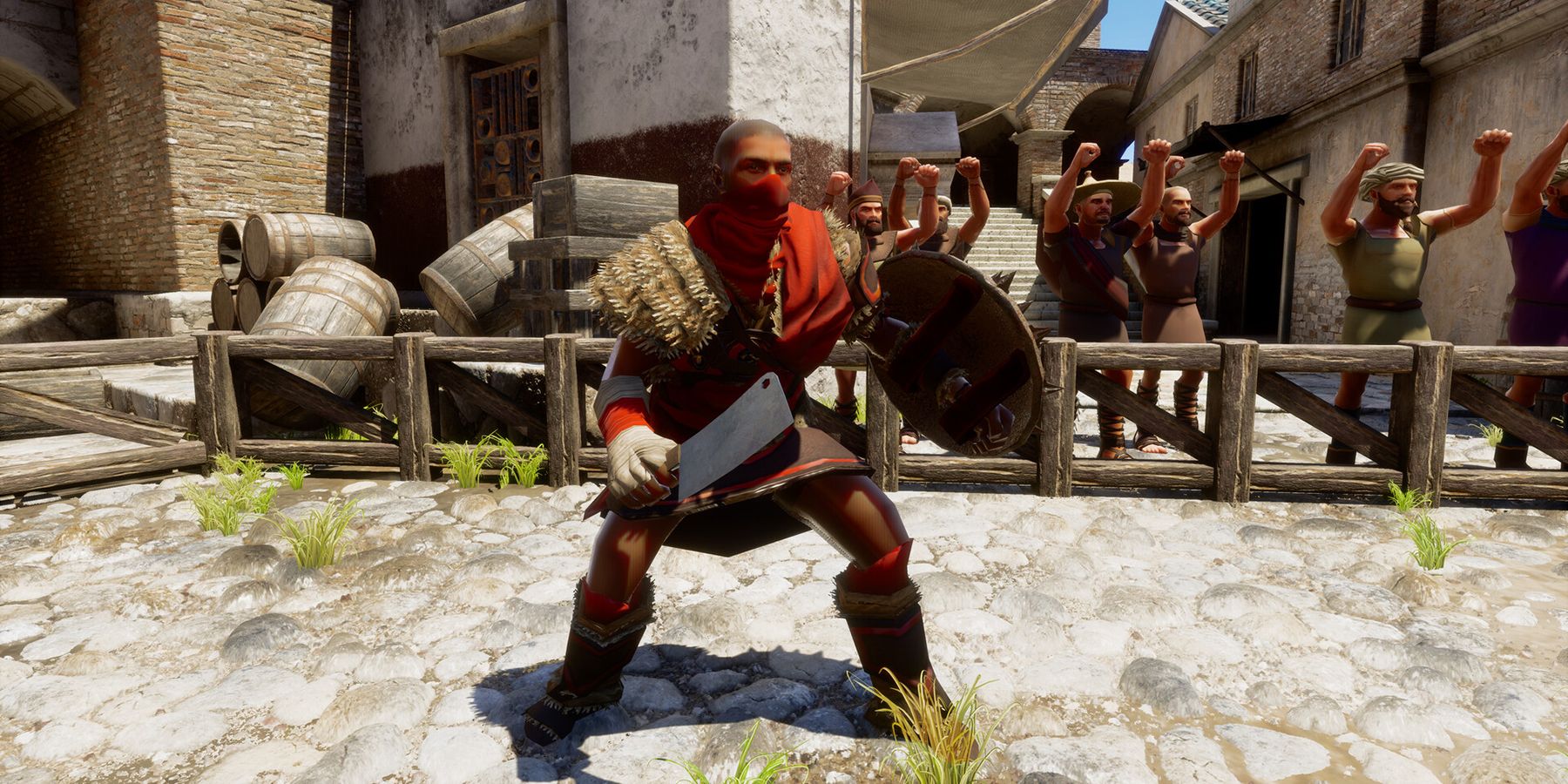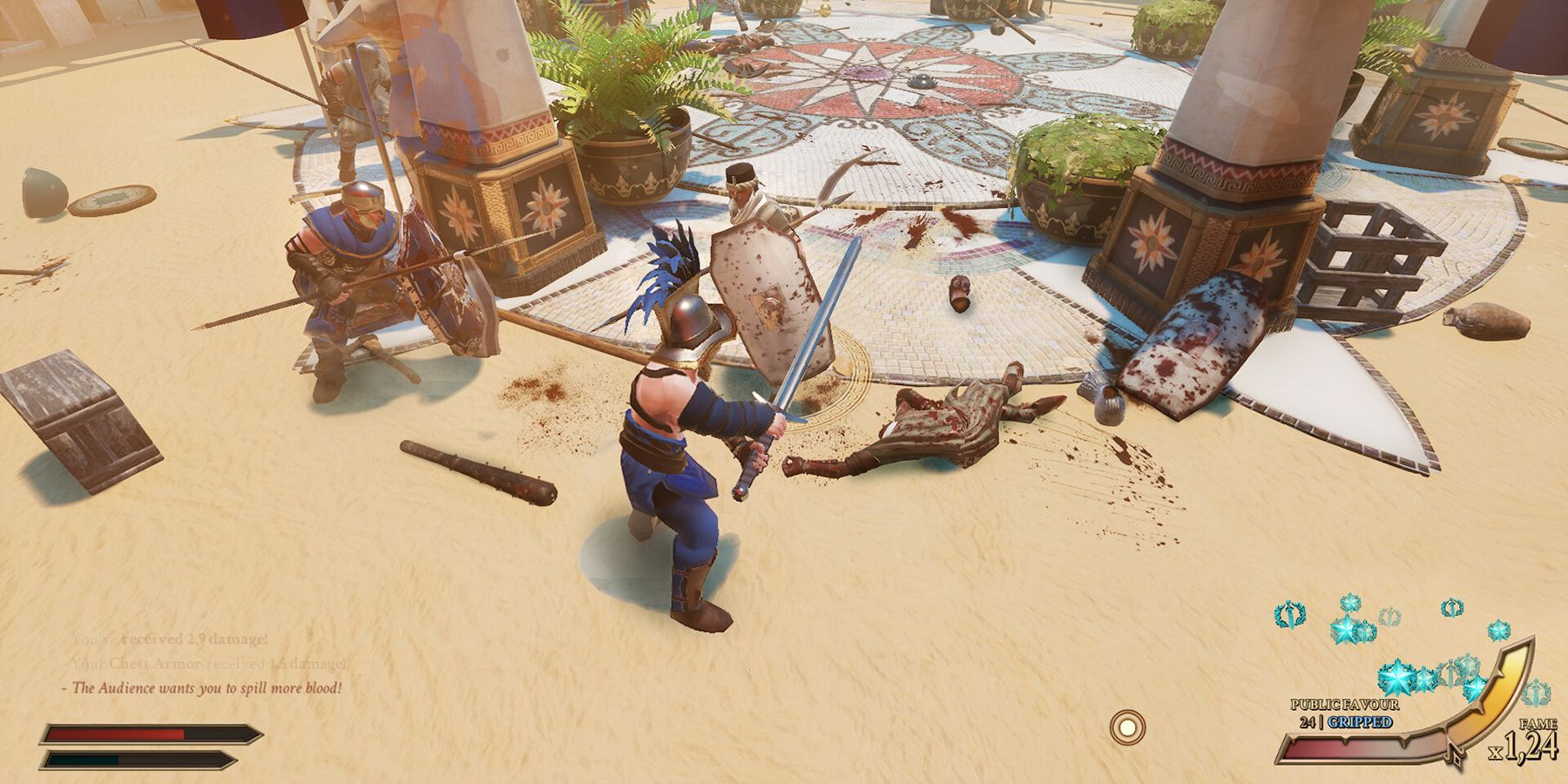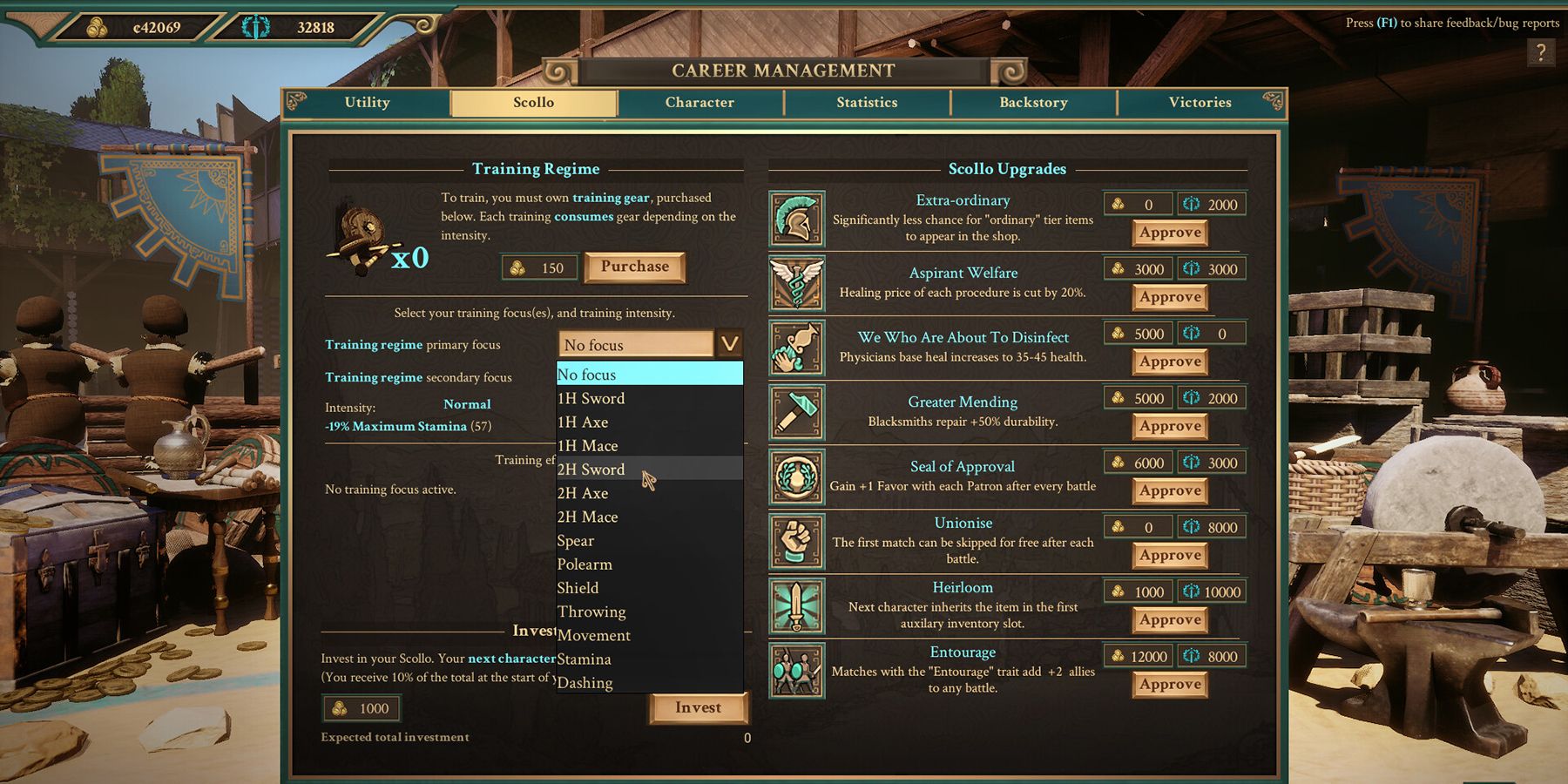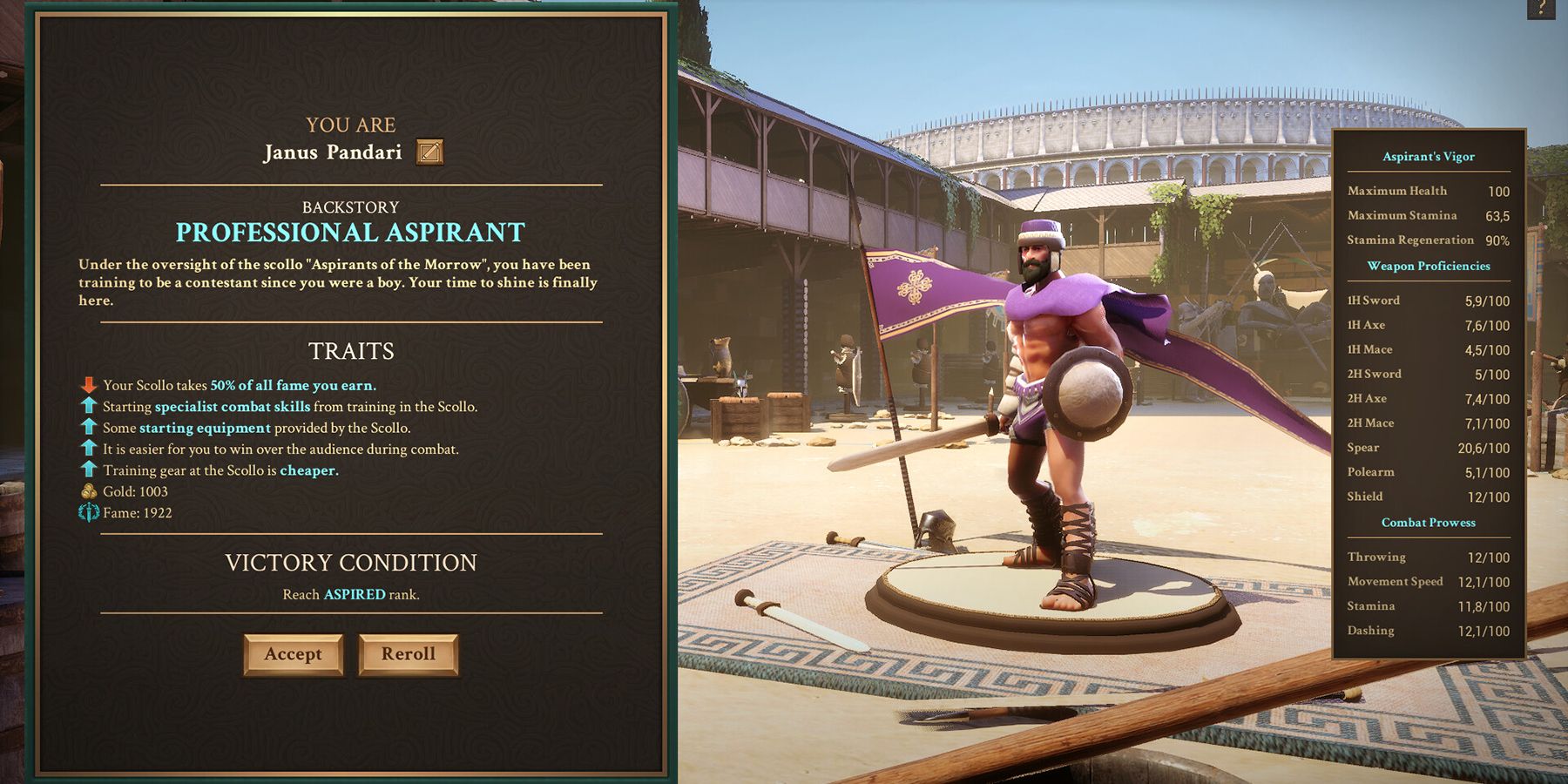Solo-developer Jordy Lakiere was completely unprepared for the tremendous response We Who Are About To Die received when it entered Early Access on Steam earlier this month. The indie game, which mixes physics-driven combat with in-depth career management, currently enjoys very positive reviews, and has garnered a huge amount of wishlists from eager players. Fans of action RPGs, roguelites, management sims, and the thrill of skill-based arena combat should take note of the new title.
Game Rant talked to Lakiere about WWAATD's launch, inspirations, innovative combat system and management sim features, as well as the final development steps leading up to the title's full launch. The following transcript has been edited for brevity and clarity.
Q: Please briefly introduce yourself and describe We Who Are About to Die to readers who are unfamiliar with the title.
A: Hello, my name is Jordy Lakiere. I’m a 31-year-old game developer from Belgium. We Who Are About To Die (WWAATD) is a gladiator themed RPG/Roguelite with in-depth career management and a unique physics simulated combat system.
Q: The game’s title is based on a famous salute from ancient Rome’s Coliseum, correct? How much did historical research inform the game design, as opposed to pop-cultural conceptions of gladiators?
A: Correct! The title has been very love it or hate it, but I thought it embodied the game in just about every way. It’s a long, complex and a bit clunky as a title just like the game. It captivates the sentiment that you will die—over and over again—while obviously alluding to gladiators.
I made the conscious decision very early on to not attempt historical accuracy as I knew I could not do it justice on my own. WWAATD is set in a fantasy world version of Rome named Terantia, which is obviously heavily inspired by Rome, Ancient Greece, Babylon and more.
Q: We Who Are About to Die recently debuted on Early Access and is quickly gaining popularity on Steam. What has that reception been like, and what is the most valuable feedback you have been given so far?
A: The reception has been quite frankly overwhelming. Not in my wildest dreams did I think the game would take off like this. I had a personal goal of 10,000 sales for the lifetime of the game, which I thought was a fairly high goal. The game sold more than 10,000 copies in the first 24 hours.
On top of development, I also did all the marketing, and the majority of the time my efforts yielded little results. The sheer vastness of the numbers I received on launch week and after launch has just been humbling. To put it into perspective, I worked hard for nearly two years to build a wishlist count of 7,000. Just in the last week alone, the game has gained 60,000 wishlists. There has been lots of amazing and valuable feedback—most comments have been about balance and difficulty. I knew I would need wider feedback to fine tune the balance which is one of the reasons for Early Access.
One problem with skill-based games such as WWAATD is that everyone who becomes familiar with the game basically stops being able to give good insight on balance and learning curve—my opinions on balance have been essentially useless or untrustworthy for a long time, so this all has been very valuable.
Q: We Who Are About to Die features a physics-based combat system, and the Steam page warns players that they will have to "re-learn how to fight." Can you shed some more light on how combat works?
A: To refer to other games, it lands a bit in between the pure physics-based nature of Exanima and the more arcadey but high-skill directional combat of Mount & Blade.
That said, it was designed mostly from the ground up and very much its own thing. In the game, attack drags essentially control your swing direction. You can pull your weapon-arm a bit like you’d pull back a spring. Your character faces your cursor position which means you can turn your torso into swings or even aim down to sweep the legs. All damage and objects are physics simulated, so the faster your weapon moves when it connects with an unfortunate enemy Aspirant—the name for gladiators in the game—the more damage you deal. Similarly, shields are physics entities. You can ‘block’ as it were, but all it does is raise your shield as your shield is always active.
The idea here is that you can control your upper body mostly with the mouse, and lower body with the keyboard, and combine any and all moves together to do just about whatever you wish. The entire combat system is animation driven and many animations are semi-procedural. In other words, the game never takes away control from you to 'play' an animation. You can always cancel, interrupt, or adjust any action. With all of these systems, people can create their own fight styles or attack moves and there’s nearly infinite possibilities for emergent gameplay.
One thing that comes with this system is a monstrous learning curve—and that challenge is not for everyone. At first, it will feel difficult to control your character at all, but as it starts clicking, you can eventually master combat and start to do some really tactical and precise, engaging combat.
Q: We Who Are About to Die also features career management aspects of play, such as selecting matchups, bribing officials for information, and more. Can you tell us a bit more about how these options will influence players’ runs?
A: I wanted to add as many interacting systems as possible to make each run and its career management unique. To start, you begin with a randomized gladiator that has a backstory. There are five now and many more to come. These backstories have their own positive and negative traits that affect the entire run.
There’s the bracket system, where you are presented random matches and must choose between them. They can be different brackets such as one-on-one, many versus many, and each bracket levels up with each victory separately. That means you can specialize into duels, for example. Higher level fights yield more rewards, like fame and gold. You can then use that gold to hire a doctor, promoter, and a smith to repair or buy equipment from a randomized shop that refreshes after every fight.
Each match is hosted by one of four patrons, if you fight in their fights you gain favor with them, but all others will lose favor. This favor can then spawn negative or positive events to do with said patron. The patrons each have a flavor (one is more focused on fame, one on money, and so on) so you can ‘spec’ into a certain thing there too. There are also random events that can happen, with both positive and negative effects that may influence your run after a week/fight passes.
Then there’s the fame system. All of your equipment all has a fame multiplier. So things like shields are not appreciated by the crowd as they are boring! Fancy helmets give bonus fame, ugly high-armor ones give a negative multiplier. In battle, the crowd will respond to your actions and either love you or hate you. The amount of fame you gain is based on your performance and gear.
There’s a lot to tell here, and I feel like I’ve barely scratched the surface. You can place bets, specify a training regime, unlock upgrades for your school and more.
Q: We Who Are About to Die features eight different weapon classes. What can you tell us about them?
A: There are one-handed swords, axes, and maces, as well as two-handed swords, axes, and maces. These are very directional animation sets with a bit more ‘standard’ gameplay. Then there are polearms (heavy hammers, bardiches, glaives, etc.) and spears.
I’ve designed all the weapon classes based on their real life properties. It is by no means a highly realistic simulator, but I noticed weapon types, their behavior, together with the physics, basically generated a set of attacks and properties that reflect real life. For example, exactly as in history, a spear and a shield is a very easy weapon to get very good results with. Less complex mechanically, still very effective, unless someone closes in on you. Two-handed weapons allow you to stay nimble and fast—and in this case, often cause some bloody kills, which riles up the audience!
There are all the basic RPG features you would expect; piercing damage and blunt does well against armor, slashing against flesh, but there are also some other features. For example, cleaving damage has a bigger chance to decapitate, which the audience loves!
Q: Would you recommend any specific builds for new players to acclimate to the game? Or do you have any must-try combinations of backstories, traits, and weapons that are too fun to pass up?
A: Early on, Professional Aspirant is currently the most forgiving backstory. Level one characters don’t know how to fight, so if the player also doesn’t know how to fight, that’s a bit much. A professional aspirant backstory starts you with some skills, so your character is already a bit more responsive at the start. I recommend players to stick to shield builds at first, and maybe even something as simple as spear and shield while they learn to navigate both movement/timing in battle and the overall career management. Spoils to the Victor is a very valuable match trait early on, it allows you to keep loot in a fight. You could even go into a battle unarmed to maximize profits. Lastly, set your training regime to Stamina early on if you struggle with stamina!
Q: Are there any cosmetic customization metrics for your gladiator, or is character creation randomized?
A: Currently, character creation is mostly randomized. The current customization is through equipment. There are eight equipment slots and an accessory (a sash, cloak, furs, or even a lion on your shoulder) which is purely cosmetic. Currently, there are over 200 items, so there are infinite possibilities, really. I also intend to add more customization eventually, including looks, team color, and so on. Right now gladiators are mostly random.
Q: Is there a story behind We Who Are About to Die, or is it primarily a mechanically-driven experience?
A: There is no story but the one of your gladiator that you made. I adore systems-based, procedural and emergent gameplay. To me, a good game is unique every time for everyone who plays it. It is a defining trait for me—the real-time nature of video games. The stories are intimate and unique to the player and will become more and more complex as I add more content -- events, for example.
Q: Sound design can be challenging, especially for solo-developers. How are you handling music and SFX for We Who Are About to Die?
A: The majority of the battle music is made by Marius Schlichting. He’s an old online friend who volunteered to do these tracks for the game. In the last year of development, when people started getting into the game, some people came forward and helped. Leonard Wolf contributed two tracks, and Tyler Cline contributed one track. I ended up learning the basics of orchestral composition in order to make the main theme for the game, but I'm glad I had these amazing artists help me out with the music.
The SFX is either copyright-free materials or homemade. The sound for swords clashing is me just banging 2 forks together! Many of the grunts and "ahs" are just my own voice. I ripped up vegetables, knocked on things, swung sticks around, tore paper and much more.
Q: What inspired you to start developing a gladiatorial roguelite? How long has the game been in development to date?
A: Seven years. I originally was seeking a simple shell around an interesting combat system. I figured a gladiator game was nice and doable; small bespoke arenas, some management, and not too much extra workload. It grew from there, obviously.
When the idea of roguelite plus gladiators hit me, I knew instantly it had potential. How did this not exist yet? It’s a perfect match. Permadeath brutality, ‘rooms’ in the form of arena-based combat, and management in between; it just made sense and I got to work immediately.
Q: What development challenges are you currently focused on, and what do you think is the greatest hurdle between the game’s current build and its V1.0 release?
A: Right now, I’m still processing the success of the game’s launch a bit—it has only been a few days. But I’ve constantly been reading reviews and feedback and have a good grasp on the most common balancing issues and bugs, that will be my first focus.
There are a lot of features and content to be added between now and 1.0, but nothing that is particularly intimidating. Controller and Steam Deck support are high on the list of priorities, and I can’t wait to get into them. As far as hurdles, general bug fixing can be very tough when you don’t find particular bugs, and I suspect localization will be a serious endeavor.
I made most of the foundational work and most of the content for the game already. Originally I was even going to skip Early Access entirely, but decided the feedback and "grace period" of an EA launch would be a great help as a solo developer. I did not anticipate the sheer scale of this launch. With my first game ever, I very much wanted to do an Early Access launch first and release in a pretty content and feature-rich state.
Q: Roguelites are becoming an increasingly popular genre with some recent stand-out entries like Inscryption, Hades, and Returnal. What sets We Who Are About to Die apart from its peers?
A: As mentioned before, with the career management system I wanted to add as many major entangling systems as possible. That way, the road to victory is complex. You can "spec" into any number of directions and I suspect by the time I’m done with Early Access, the way people manage their careers will be very different from one person to the next. One might focus on showing off to the audience, wearing fancy gear. Another might wear high armor and disregard fame. Some might focus on patrons and their events, on bribery and subterfuge and so on.
The main difference however is how mechanically complex the combat is. I wanted career features to be broad horizontally, but combat very broad mechanically. Most roguelites have skill-based combat but don’t take the risks that I could as an unpublished solo developer.
Q: Do you have any advice for fellow solo-developers? Any lessons that you wish you knew when you first started out?
Don’t spend seven years, haha! Unless you already have a financially sound situation setup. I have a part-time job as a college lector of concept art which allowed me to make this game. Despite this being my first released/completed game ever, I had a lot of game development-related skills already that I’ve been developing since childhood, since I used to mod games.
This project took everything out of me. Thousands of hours of work, dozens of vastly different skill sets—many of which had to be learned from scratch—all the emotional and motivational highs and lows operating under a blind faith that some day, some year, someone would hopefully care enough about the game to be enticed to purchase it. It is not something I recommend. I treated it as a hobby and I may just be a bit mad. Start small.
Q: Is there anything else you would like readers to know?
I just want to thank anyone who reads this for their time—the last few days have been nothing short of life-changing, and being able to share my story after many quiet, uncertain and challenging years, is something I will never take for granted. I’ve dreamed and fantasized about this scenario for so long that I’m still convinced I’ll wake up any minute now.
And if I don’t—keep playing games, and I’ll keep making ‘em!
[END.]
We Who Are About To Die is available now on Steam via Early Access.




